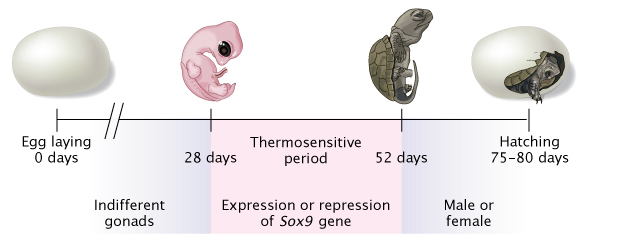« Prev Next »
Thus, there appear to be certain situations in which the environment affects not only the growth and health of an organism, but also the use or deployment of the organism's genes. Does this mean that genes aren't, in fact, everything? The observation that genetically identical organisms often vary greatly in phenotype clearly shows that gene-environment interaction is indeed an important regulator of phenotypic variation, including variation related to a number of diseases. In fact, the impact of environmental factors on disease etiology (or causation) has gained greater recognition in recent years. This has led to the conclusion that both genes and environment can affect disease—not just separately, but through direct interaction with each other. This relatively new attitude presents considerable challenges, as well as surprising benefits, for the study of human disease.
Environment Can Impact Phenotype
Scientists have long appreciated the role that environmental factors play in the production of traits in animals. Environmental factors such as diet, temperature, oxygen levels, humidity, light cycles, and the presence of mutagens can all impact which of an animal's genes are expressed, which ultimately affects the animal's phenotype. For this reason, scientists who study the genetics of model organisms usually seek to minimize environmental influence by maintaining constant environmental conditions for the organisms under study. Nevertheless, even genetically identical organisms exposed to controlled experimental conditions can have different phenotypes, pointing to the power of subtle environmental differences on gene expression.
Sensing Environmental Changes
Of course, most organisms are exposed to changing conditions, and in these cases, it is often difficult to imagine how the organisms' genes "sense" alterations in the environment. Consider the case of the crocodile. Scientists know that the temperature at which a crocodile egg is incubated influences the sex of the resulting baby crocodile, but how does the DNA in the egg "learn" about changes in temperature? Moreover, upon sensing such changes, how does the egg "know" to change the expression of genes to alter the sex of the developing crocodile?

Genotypes That Alter Environment

More recently, scientists have examined how different polymorphisms in humans may impact the effectiveness of chemoprevention, or the use of medicines to prevent cancer. For example, data suggest that taking a daily low-dose aspirin, long known to be important in heart health, may also have an impact on colorectal cancer risk in some patients. In particular, two studies connected aspirin usage to cancer prevention, but only in one subset of users — those with a specific allele of a gene called UGT1A6, which is involved in aspirin metabolism. Protection from cancer was only found in the group of patients who were slow aspirin metabolizers (Figure 2). The actual mechanism by which aspirin mediates this protective effect remains unknown.
Many Genes, Many Environmental Influences, Many Phenotypes
The number of combinations of different genotypic variants, environmental conditions, and possible phenotypes is not something researchers can predict. However, the complex interactions of multiple genetic loci with diverse environmental signals suggest that scientists must continue to develop novel methods of studying these situations, such as by simultaneously examining thousands of genes using techniques like microarray technology under different environmental conditions. While we may never be able to predict an exact phenotype, it is clear that when trying to understand biology and human disease, we must consider interactions of genes and environment in our analysis.
References and Recommended Reading
Hunter, D. J. Gene-environment interactions in human disease. Nature Reviews Genetics 6, 287–298 (2005) doi:10.1038/nrg1578 (link to article)
Lower, G. M., et al. N-acetyltransferase phenotype and risk in urinary bladder cancer: Approaches in molecular epidemiology. Preliminary results in Sweden and Denmark. Environmental Health Perspectives 29,71–79 (1979)
Pieau, C., & Dorizzi, M. Oestrogens and temperature-dependent sex determination in reptiles: All is in the gonads. Journal of Endocrinology 181, 367–377 (2004) doi:10.1677/joe.0.1810367
Pieau, C., et al. Temperature sensitivity of sexual differentiation of gonads in the European pond turtle. Journal of Experimental Zoology 270, 86–93 (1994) doi:10.1002/jez.1402700110
Riordan, J. R., et al. Identification of the cystic fibrosis gene: Cloning and characterization of complementary DNA. Science 245, 1066–1073 (1989)
Rommens, J. M., et al. Identification of the cystic fibrosis gene: Chromosome walking and jumping. Science 245, 1059–1065 (1989)



 Figure 2: Gene-environment interactions from epidemiological studies
Figure 2: Gene-environment interactions from epidemiological studies


























